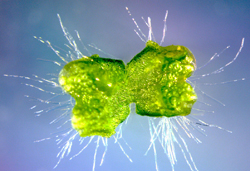A New Crop of Plant Model Systems is in Full Bloom
Cell Biology & Molecular Genetics’ Caren Chang discusses existing and emerging plant model systems
Model organisms are widely used in laboratories as a stand-in for closely related organisms. For instance, mice are a proxy for mammals—including humans. Other common model organisms include E. coli for bacteria, budding yeast for fungi and fruit flies for invertebrates. In plants, the model organism of choice is Arabidopsis thaliana, a small flowering plant also called thale cress.
 Arabidopsis is a popular model organism—according to a review article published in October 2016 in the journal Cell, in 2010 there were more papers published on Arabidopsis than on the fruit fly or budding yeast. But it’s got competition, as more plants are gaining attention as model organisms thanks to advances in genomic and genetic technologies.
Arabidopsis is a popular model organism—according to a review article published in October 2016 in the journal Cell, in 2010 there were more papers published on Arabidopsis than on the fruit fly or budding yeast. But it’s got competition, as more plants are gaining attention as model organisms thanks to advances in genomic and genetic technologies.
Caren Chang, coauthor of the review and professor of cell biology and molecular genetics at the University of Maryland, helped pioneer the use of Arabidopsis as a model organism while working on her PhD with Elliot Meyerowitz, her advisor at the California Institute of Technology. Chang published the first cloning and sequencing of a gene in Arabidopsis, and the first DNA map for Arabidopsis that was made to help researchers clone genes of interest based on gene locations on the map. Today, Chang continues to work on Arabidopsis and other plants. Her laboratory focuses on the gaseous hormone ethylene, which controls many crucial plant processes including seed sprouting, fruit ripening and responses to stress.
We sat down with Chang to get her thoughts on the future of plant model systems.
Why are model plant systems important?
We depend on plants in our daily lives. Agronomists talk about the “four Fs” that humans obtain from agriculture: food, feed, fuel and fiber. With climate change and a growing population, we need to study plants in order to use them to sustain more people and animals in a changing world.
In addition, many medicines come from plants. For instance, aspirin was developed from salicylic acid, which was first isolated from willow bark. Plants are also the source of many other drugs ranging from chemotherapy agents to anti-malarial pills.
Scientists have also made discoveries in plants that apply to humans and animals. Barbara McClintock famously discovered transposable elements— short bits of DNA that can physically move around within a genome—in corn. It turns out that these elements make up 44 percent of the human genome. And cryptochromes—circadian clock genes that regulate human sleep cycles and are the reason you aren’t supposed to look at blue lights before bed—were first discovered and cloned in Arabidopsis.
Plants also play an important role in our environment. For instance, they provide oxygen to the atmosphere, anchor the topsoil in place, remove carbon dioxide from the air and provide food and shelter for wildlife ranging from insects to mammals.
For the sake of our future, we must understand plants.
How have researchers selected existing plant model systems, such as Arabidopsis?
In the beginning, scientists chose whatever plant was at hand or important to study. Historically, the intersection of those two factors was a crop plant. For instance, Gregor Mendel, who is considered the founder of genetics, made his discoveries by crossing pea plants. The first virus ever discovered was the Tobacco Mosaic Virus, which infects a wide range of plants and was studied as far back as 1886. Researchers still study the tomato plant today because it breeds quickly, is easy to mutate, has a small genome and can be grown anywhere. Corn, rice and soybeans are also studied extensively today.
Arabidopsis is not a crop, so it wasn’t studied that early. Arabidopsis was first proposed as a model organism in 1943 because researchers believed it would be easy to work with. It grew quickly and it was small enough to plant anywhere. Those characteristics are important for growing a research community around a plant model system. They also help rule out a lot of crops that only grow in certain non-reproducible climates, have extremely long life cycles, or are too large to plant easily. For instance, scientists sequenced the genome of the date palm in 2011, but it takes five to eight years to flower after you plant it—that’s just not practical.
By 1943, scientists had begun developing what are often called classic genetic techniques for manipulating and learning about an organism’s genes. Arabidopsis was easy to manipulate with classical genetic techniques, which is not true of all plants. Arabidopsis also has a remarkably small genome compared to crop plants. These factors have helped to attract a research community and resources to study Arabidopsis. Even before researchers sequenced the Arabidopsis genome—before next-generation sequencing techniques existed—Arabidopsis became the model plant organism of choice.
Where are new plant model systems coming from?
There has always been plenty of interest in these “new” systems, but they are being explored a lot more now, enabled by advances in molecular and genomic technologies.
For genomics, when the first high-throughput sequencing platforms launched about a decade ago, it became possible to sequence pretty much anything you wanted for much less effort and money than before. So scientists jumped on that chance. And once you have a genome, then you can do lab work based on what you find in the genome using computational biology. Before high-throughput sequencing, scientists would do lab work to discover genes of interest and then sequence those genes, so I think the current process is an interesting inversion of the old workflow.
It’s a similar story with CRISPR, which is a new targeted genome editing technique that makes it possible to manipulate a wide variety of genes in all kinds of organisms, including the plants that don’t respond well to classical genetic techniques. CRISPR has opened up many more plants for possible study.
New technologies are really lowering the barrier to entry for new plants that don’t have all the properties that made Arabidopsis and other older model systems so suitable for study. But these newer models are still very important for other reasons such as their unique physiology, interesting evolutionary features or societal value.
We included 42 existing and up-and-coming plant model systems in our review paper, and that list was incomplete. There are probably another 50 that we didn’t cover. Of the 42 model plants that we listed, 11 have completed genomes, 21 have nearly completed genomes and the rest are in progress.
Once the genomes are sequenced, you can do comparative genomics to find candidate genes that you might be interested in. For instance, you may find genes that are shared across all plants, which would suggest they perform some kind of basic biological function. As an example, all plants photosynthesize, so you’d generally expect to see those genes. But maybe you discover something else that all plants appear to share, and that would be interesting to explore.
On the flip side, comparative genomics will also let you pluck out the genes that are unique to certain plants. Those genes could be interesting because they might be completely specialized for that plant, and could teach you about how that plant is adapting to its environment.
What do these emerging plant model systems have to offer?
New plant model systems are allowing scientists to study food crops such as grapes, strawberries and corn, bioenergy crops such as switchgrass, and specialized processes like nitrogen fixation in legume plants such as birdsfoot trefoil, that have symbiotic bacteria in their root nodules capable of the process.
Zhongchi Liu, also a professor in the Department of Cell Biology and Molecular Genetics at UMD (and a former postdoctoral researcher in the Meyerowitz lab), used to study Arabidopsis exclusively, but she now conducts research on strawberries, raspberries and trees. In 2016, she published an article in the journal Scientific Reports demonstrating that a gene variant turns strawberries—a valuable fruit crop—yellow instead of red.
We’re also starting to look at plants that can teach us about adaptation. In this case, sometimes it’s helpful to study things close to home. For instance, Eutrema salsugineum is a close relative of Arabidopsis that tolerates salt very well. The salinity of water is increasing all over the world, so we’d like to learn Eutrema’s tricks to create salt-tolerant plants.
Finally, Arabidopsis is a very modern plant in terms of evolutionary lineage, so when it comes to basic research, it mostly teaches us about modern plants. One ancient plant that’s being studied right now is the liverwort, which tells us about the very first land plants. It would be great to have more plant genomes spanning even further back in evolutionary history, all the way to single-celled algae living in the water, which are the most primitive plants of all. Then we could gain insight into big evolutionary steps, such as the transition from water to land.
###
The researchers who contributed to the review article are supported by the National Science Foundation (Award No. MCB-1244303), the Maryland Agricultural Experiment Station, the Australian Research Council (Award No. DP160100892), the Howard Hughes Medical Institute, the Gordon and Betty Moore Foundation (Award No. GBMF3406), and the National Institutes of Health (Award No. R01GM104244). The content of this article does not necessarily reflect the views of these organizations.
The review paper, “Field Guide to Plant Model Systems,” Caren Chang, John Bowman, Elliot Meyerowitz, was published in the journal Cell on October 6, 2016.
The research paper, “Molecular cloning and DNA sequence of the Arabidopsis thaliana alcohol dehydrogenase gene,” Caren Chang and Elliot Meyerowitz, was published in the journal Proceedings of the National Academy of Sciences in March 1986.
The research paper, “Restriction fragment length polymorphism linkage map for Arabidopsis thaliana,” Caren Chang, John Bowman, Arthur DeJohn, Eric Lander and Elliot Meyerowitz, was published in the journal Proceedings of the National Academy of Sciences in September 1988.
The research paper, “Genome-scale DNA variant analysis and functional validation of a SNP underlying yellow fruit color in wild strawberry,” Charles Hawkins, Julie Caruana, Erin Schiksnis and Zhongchi Liu was published in the journal Scientific Reports on July 5, 2016.
Media Relations Contact: Irene Ying, 301-405-5204, zying@umd.edu
University of Maryland
College of Computer, Mathematical, and Natural Sciences
2300 Symons Hall
College Park, MD 20742
www.cmns.umd.edu
@UMDscience
About the College of Computer, Mathematical, and Natural Sciences
The College of Computer, Mathematical, and Natural Sciences at the University of Maryland educates more than 7,000 future scientific leaders in its undergraduate and graduate programs each year. The college’s 10 departments and more than a dozen interdisciplinary research centers foster scientific discovery with annual sponsored research funding exceeding $150 million.








